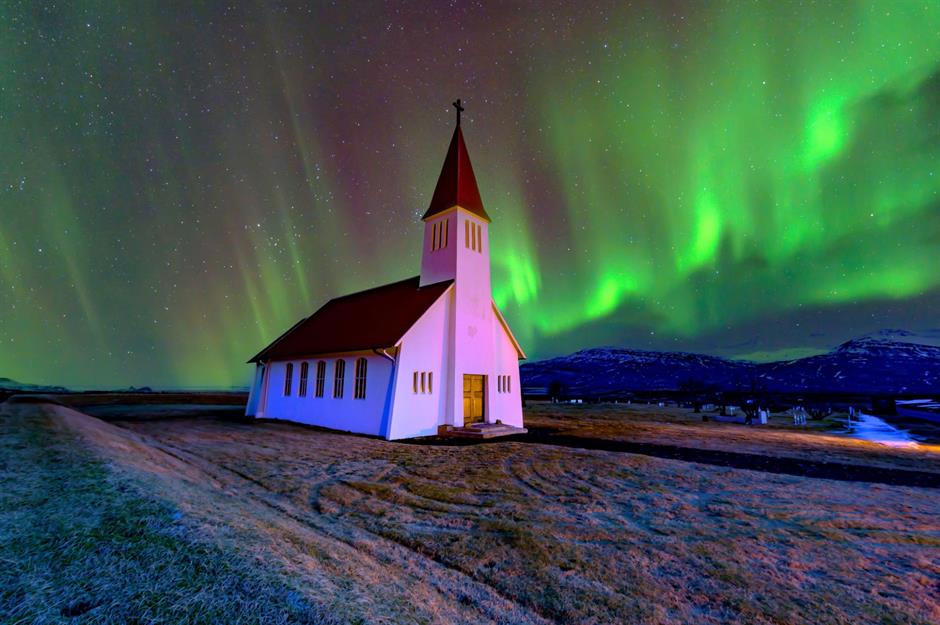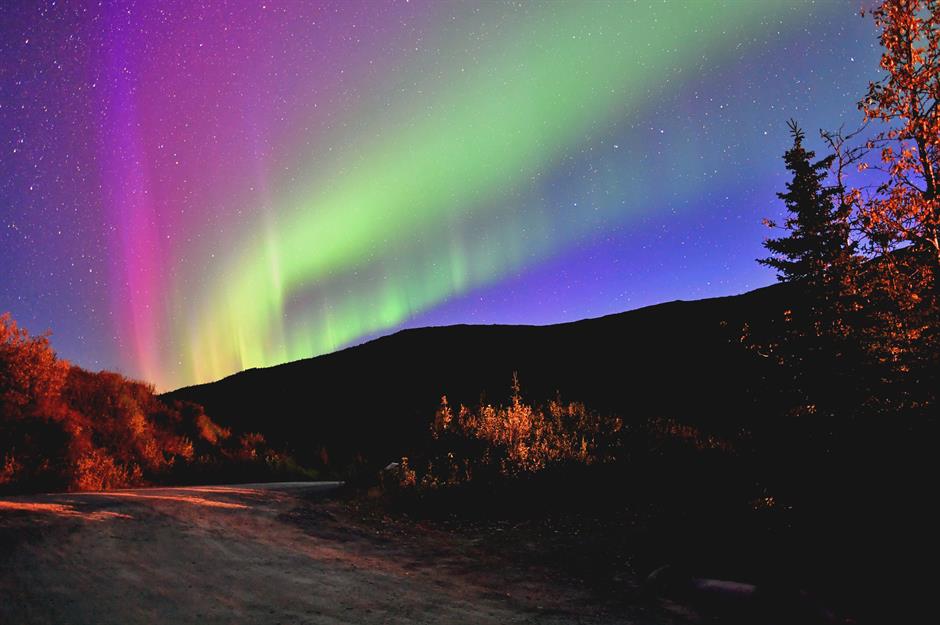30 stunning images of the Northern Lights
Trip the light fantastic
You don’t necessarily have to head to the Arctic Circle to see the Northern Lights. From Scotland to Canada, Iceland and Norway, there are a whole host of picturesque locations for observing this spectacular natural phenomenon. They offer a huge diversity of spectacle, with colours ranging from vibrant green to intense violet and even acidic orange.
Denali National Park, Alaska
In Alaska, Denali National Park and Preserve covers over six million rugged, wild acres, and the Northern Lights are a common sight during the autumn, winter and spring months. However, the optimum time to visit is winter, when the forests, glaciers and rocky landscapes that comprise Denali are enveloped in near-constant darkness.
Denali National Park, Alaska
The park is also easily reached from Alaska’s largest city, Anchorage: it’s five hours by car or 90 minutes by air. While the train takes around eight hours, this can be an event in itself. Especially when travelling by dome cart with Alaska Railroad through otherwise inaccessible wilderness. Perhaps you’ll even spot Lady Aurora from the comfort of your chair.
Kirkjufell, Iceland
Located in the Snæfellsnes Peninsula near the town of Grundarfjörður, the pointed peak of Kirkjufell mountain is one of Iceland’s most iconic inhabitants, measuring 1,519 feet high (463m). Within walking distance is another picture-perfect sight: Kirkjufellsfoss, which means ‘Church Mountain Waterfalls'. The area’s natural beauty is only enhanced by the aurora borealis (another name for the Northern Lights), sometimes referred to as the ‘merry dancers’.
Kirkjufell, Iceland
Photo tours are common in Kirkjufell and beyond, led by professional photographers experienced in navigating difficult terrain, unpredictable weather conditions and witnessing the elusive lights themselves, which are often associated with the colour green but can also appear pink, blue and often white-grey (like in this image).
Tromsø, Norway
Like stargazing, hunting for the Northern Lights requires dark skies – and patience. And dark skies generally require getting as far away from civilisation (and more specifically, light pollution) as possible. But some special settlements, like Tromsø, Norway (with population of 78,000), are nevertheless perfectly-located for the activity. Why? Northern Norway's largest city is located under the auroral oval – a huge belt encircling the North Pole where the phenomenon is at its most intense.
Tromsø, Norway
That said, the city is a great gateway to other, more remote viewing points for seeing the spectacle. Pictured is Oldervik, a charming fishing village located in the same multiplicity as Tromsø and a short drive from the city. Explore the region further with guided light chaser tours on everything from vans and buses to Arctic trucks and UTV buggies.
Love this? Follow us on Facebook for more travel inspiration
Yukon, Canada
Back to North America and Yukon Territory in Canada, a vast swathe of wilderness covering 186,661 square miles (483,450sq km) (that's about the size of mainland Spain) – pictured is the 78-square mile (201sq km) Lake Laberge. Sometimes, January temperatures in the region are as low as -30°C (-22°F), but the lights are visible from mid-August to mid-April, so it's possible to avoid the punishing coldness.
Yukon, Canada
Still, the Yukon is beloved for its snow-dusted scenery, which you can enjoy when combining your aurora adventure with an array of winter activities. For example, in addition to a specialised excursion, there are tours that incorporate a sightseeing flight, dog-sledding and snowmobiling, plus a visit to Takhini Hot Springs.
Isle of Skye, Scotland, UK
It is possible to see the Northern Lights outside of the Arctic Circle – for example, in Scotland, the UK country that’s closest to the North Pole. As well as the Scottish Highlands, a specific example is the northwestern Isle of Skye, known for its jagged coastline, located some 636 miles (1,024km) away from that imaginary circle that runs parallel to the equator.
Isle of Skye, Scotland, UK
Be warned, however: although possible, sightings of coloured aurora here are rare. The lights more often appear white or grey to the naked eye, with colours emerging when photographed using a long exposure. Helpfully, the island has its own ‘aurora alert’ Twitter feed to help better your chances of seeing nature’s greatest theatrical show. Maximise the possibility by visiting in October.
Michigan, USA
Scotland isn't the only place you might be surprised to learn the Northern Lights can be seen from: they've also been sighted in the likes of Ireland, Germany, Switzerland and – believe it or not – Michigan USA. The US state, which shares a border with Canada, is home to 11,000 lakes (including Lake Michigan, pictured, reaching into four states), bestowing the area with extremely low light pollution.
Michigan, USA
The lakes offer great viewing conditions due to the lack of tree and hill obstruction as, in Michigan, the lights appear low on the horizon due to its latitude. You could further optimise your chances by hitting Headlands International Dark Sky Park which, in 2011, became the sixth International Dark Sky Park in the US and the ninth in the world. Peak months for aurora-spotting in Michigan’s Upper Peninsula are April, October and November.
Nuuk, Greenland
Meanwhile, Greenland – the world’s largest island – is as synonymous with the Northern Lights as Iceland or Norway, and the best time to see them is between August and April. What’s more, it boasts 300 clear sky days a year. Intriguingly, the lights occur all year round, but aren’t visible when the midnight sun shines bright across the Arctic Circle.
Nuuk, Greenland
What’s more, because Greenland’s settlements are so sparsely-populated – from the capital, Nuuk, pictured, home to 57,000, and the second-largest city, Sisimiut, home to just 5,400 – you needn’t travel far from civilisation to be in with a chance of seeing the Northern Lights. In fact, you might even see them from your hotel room!
Lapland
The Northern European region of Lapland makes up a third of Finland’s land mass. However it also stretches into the snow-covered forests of Norway, Sweden and even Russia (more on which in a moment). As well as offering prime viewing spots for the lights, the region has some pretty cool accommodation options, from Sweden's ICEHOTEL to the glass igloos of Hotel Kakslauttanen in Finland, purpose-built for the lights.
Lapland
The aurora hunting industry in Lapland is pretty well-developed. Also known as Lapland safaris, you can find a tour to suit any taste – perhaps one combining the lights with wildlife: moose, reindeer and lynx are just some of the animals that live here. Alternatively, you could go cruising along the coast of Norwegian Lapland for unparalleled viewing opportunities.
Abisko National Park, Sweden
Zoning in on Swedish Lapland in particular, Abisko National Park is regarded as one of the world's best places to see the Northern Lights. This is illustrated by the fact that one of its top tourist attractions is the Aurora Sky Station: an observation centre accessed by chairlift up Mount Nuolja. Search for the lights while also visiting an exhibition that offers a deep dive into the phenomenon, plus a stylish restaurant offering four-course dinners.
Abisko National Park, Sweden
Whether in curtains or spirals or flashes, what makes Abisko National Park – and, on its doorstep, the settlement of Abisko – a prime spot for seeing the aurora borealis? The synchronicity of perfect location (under the auroral oval), a lack of light pollution (the nearest town, Kiruna, is over an hour away) and finally a steady, clear and dry microclimate owing to mountain formations.
Svalbard, Norway
Svalbard is worth a visit for its fascinating geography alone: this tiny collection of islands is found deep in the Arctic Ocean, 400 miles (640km) off the coast of Norway, and 650 miles (1,050km) from the North Pole. As such, it's home to the world's northernmost airport. With a landmass of just 23,561 square miles (61,022sq km) and with a population of only 2,667 people, it’s hard to imagine somewhere more remote to get in touch with Mother Nature. Plus, it’s home to polar bears!
Svalbard, Norway
Drink in the archipelago’s dramatic landscapes, from alluring fjords to jagged mountains, or simply stay in the capital, Longyearbyen: wherever you are, upon nightfall, there’s a high probability of seeing the lights. Part of the Kingdom of Norway, you can download the Norway Lights app for all the latest information on the lights here and back on the mainland.
Want more tips for visiting southern Norway? Check out our guide here
Kola Peninsula, Russia
Located almost entirely in the Arctic Circle, Russia's Kola Peninsula spills into Lapland. Tour operators based out of the capital, Murmansk, offer a range of products delving deep into the ether. On this tour, you can hunt for the lights while relaxing in an outdoor hot tub, or perhaps while enjoying a spot of ice fishing.
Kola Peninsula, Russia
Beyond the Peninsula – and the likes of Imandra Lake (pictured) – Russia offers abundant opportunities for spotting the merry dancers, caused by colliding electrical charged particles entering the Earth’s atmosphere. Among them are the northerly cities of Arkhangelsk and Vorkuta. There are doubtless many untold locations beyond, but they’re near-impossible to get to, given over half of Russia is uninhabited.
Lofoten, Norway
In Norway’s Lofoten archipelago, a serene island chain sits proudly within the Arctic Circle, offering jagged peaks, calm waters and picturesque fishing villages like Hamnøy (pictured). From here the Northern Lights are a frequent sight from August to October.
Now check out these 13 unexpected places where you can see the Northern Lights
Lofoten, Norway
This area of Norway is also located beneath the auroral oval, like Tromsø. What's more, Lofoten’s many beaches are perfect for unobstructed views of nature's light show. Why not combine the experience with kayaking, snowshoeing or horseback riding?
Moray Coast, Scotland, UK
Moray Coast, Scotland, UK
In this striking image captured in February 2021, the aurora borealis dance above military defences from the Second World War in Lossiemouth. The phenomenon has been spotted all over Scotland this year, and in some parts of Cumbria, in northern England, in early November. Although generally the further north you go, the more likely you are to see them.

